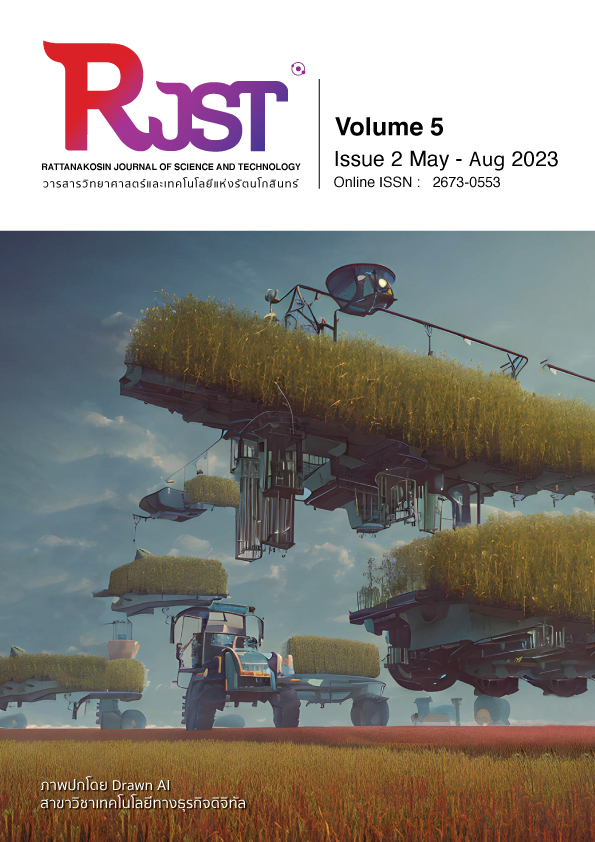Increasing Efficiency Lean Warehouse Management A Case Study Plastic Pellet Factory
Main Article Content
Abstract
The objective of this research is to improve the efficiency of the outbound logistics process for inventory management at the warehouse of a plastic pellet manufacturing factory, which serves as a case study. The study began by analyzing the process of issuing document A using time study, flow process chart, flow chart, and brainstorming to identify two problems. 1) The lack of clear storage locations for inventory, resulting in waste in the outbound logistics process. The proposed solution was to prioritize inventory using ABC analysis to reduce the time required for outbound logistics and to redesign the warehouse storage space. 2) The lack of product labeling, resulting in waste in the search process for inventory in the warehouse. The proposed solution was to use visual control tools to label products. The solution was to use visual control tools to label products. The research found that before the improvement, the time required for issuing document A was 2,085.21 seconds and the distance traveled was 425 meters. After the improvement, the time required was reduced to 1,484.77 seconds and the distance traveled was reduced to 165 meters, a decrease of 600.44 seconds or 28.80%, and the distance traveled was reduced to 260 meters, a decrease of 61.18%.
Article Details

This work is licensed under a Creative Commons Attribution-NonCommercial-NoDerivatives 4.0 International License.
The content within the published articles, including images and tables, is copyrighted by Rajamangala University of Technology Rattanakosin. Any use of the article's content, text, ideas, images, or tables for commercial purposes in various formats requires permission from the journal's editorial board.
Rajamangala University of Technology Rattanakosin permits the use and dissemination of article files under the condition that proper attribution to the journal is provided and the content is not used for commercial purposes.
The opinions and views expressed in the articles are solely those of the respective authors and are not associated with Rajamangala University of Technology Rattanakosin or other faculty members in the university. The authors bear full responsibility for the content of their articles, including any errors, and are responsible for the content and editorial review. The editorial board is not responsible for the content or views expressed in the articles.
References
สุรธันย์ ปาละพรพิสุทธิ์. (2560). Lean Manufacturing 4.0. กรุงเทพฯ: ไอ พี อาร์ ไอ.
เกียรติขจร โฆมานะสิน. (2550). LEAN: วิถีแห่งการสร้างคุณค่าสู่องค์กรที่เป็นเลิศ. กรุงเทพฯ: สถาบันเพิ่มผลผลิตแห่งชาติ.
Lonnie Wilson. (2015). How To Implement Lean Manufacturing. McGraw-Hill Professional
Paul A. Myerson. (2015). Supply Chain and Logistics Management Made Easy: Methods and Applications for Planning, Operations, Integration, Control and Improvement, and Network Design. Pearson FT Press.
กิตติวัฒน์ สิริเกษมสุข. (2565). การศึกษาการทำงานอุตสาหกรรมเพื่อการผลิตแบบลีน. กรุงเทพฯ: สำนักพิมพ์จุฬาลงกรณ์มหาวิทยาลัย.
รัชต์วรรณ กาญจนปัญญาคม. (2562). การศึกษางานอุตสาหกรรม. กรุงเทพฯ: สำนักพิมพ์ท้อป.
วันชัย ริจิรวนิช (2555). การศึกษาการทำงาน: หลักการและกรณีศึกษา. กรุงเทพฯ: สำนักพิมพ์แห่งจุฬาลงกรณ์มหาวิทยาลัย.
สมศักดิ์ ตรีสัตย์. (2562). การออกแบบและวางผังโรงงาน. กรุงเทพฯ: สมาคมส่งเสริมเทคโนโลยี (ไทย-ญี่ปุ่น).
Michael L. George, John Maxey, John Maxey and John Maxey. (2004). The Lean Six Sigma Pocket Toolbook: A Quick Reference Guide to 100 Tools for Improving Quality and Speed. McGraw-Hill Professional

